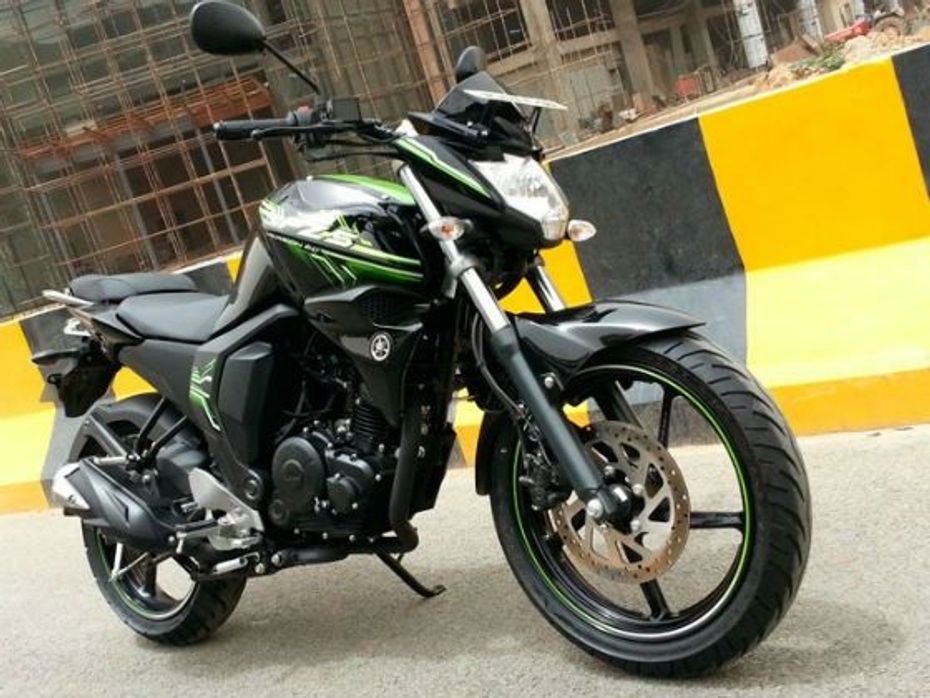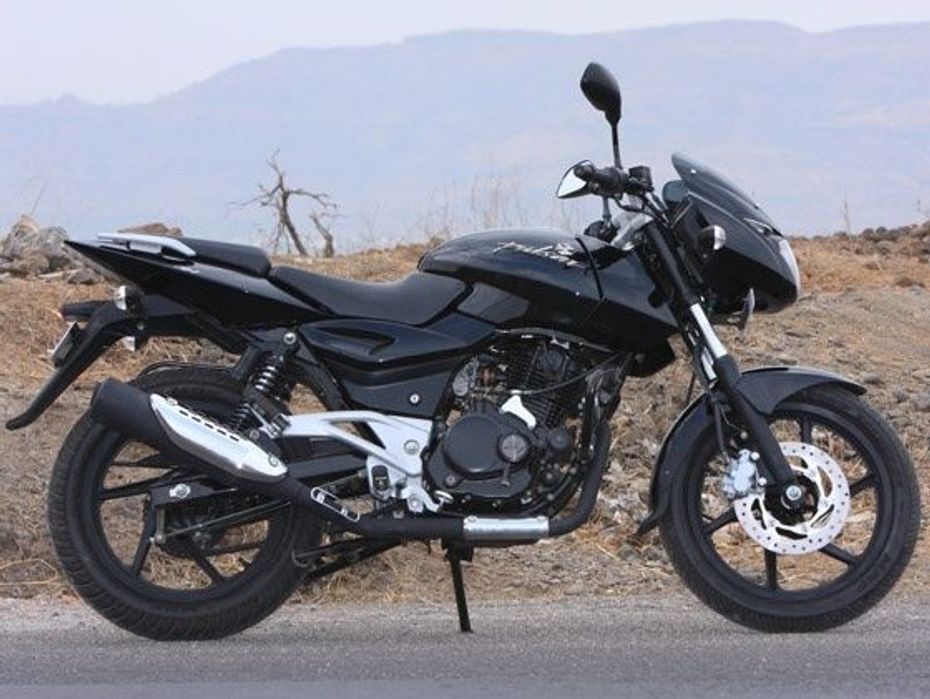
Yamaha FZ FI v2.0 vs v1.0 vs Suzuki Gixxer : Review : PowerDrift
- Sep 27, 2014
- Views : 604681


The FZ series from Yamaha India, including the FZ-16, FZ-S and half faired Fazer variants, have all seen considerable success since their launch in 2008. The FZ is Yamaha’s best selling motorcycle, and indeed a favourite 150cc motorcycle among two wheeler enthusiasts.
Muscular looks accentuated by a fat rear tyre, flawless handling and top notch quality made it popular among the trendy young crowd. But fuel consumption was not one of its strengths, and it’s primarily due to this reason Yamaha could never rule the sales charts in the 150cc segment.
Now the FZ gets revised styling – sharper looks and a redesigned rear end. But it’s the technology which gets a proper revamp on the FZ V2.0 – the new motorcycle gets fuel injection and an all-new engine.
We take a look at how the V2.0 FZ’s specifications stack up against the competition.
Design and Features:
Overall, Yamaha has retained the butch looks of the older FZ – fat muscular tank, 140mm rear tyre, wide handlebar and a meaty exhaust. The headlight is a newly designed unit; the fuel tank extensions get meatier, side panels are newly designed and the instrument console is all new, and now sports an “Eco indicator” which indicates when the bike is being ridden for optimal fuel consumption.
But it’s towards the rear end of the bike where the changes are more apparent. The fat rear tyre is now somewhat partly hidden by a rear tyre hugger; the seat is now split for more comfort for both the pillion as well as the rider; split grabrails taper off to an all-new taillight assembly; and the motorcycle also gets a completely new exhaust end can.
Beauty is subjective, but overall fit and finish of the Yamaha is top notch and the FZ certainly is one of the best looking motorcycles amongst the 150s.
In comparison, Honda’s CB Trigger exudes good looks, and even though it looks slightly understated, the motorcycle has a solid stance and sharp lines.
TVS Motor Company’s Apache RTR wears its sporty looks very well, combined with daytime running LED lights, digital console and race-inspired carbon fibre bits.

Aerodynamic tank flaps, aggressive masked fairing with stylish headlamps and a sharp tail with dual LED taillights gives the Bajaj Pulsar DTSi the butch looks which still makes it immensely popular. Over the years however, the Pulsar has started to look all-too-common and a little dated on the streets.
The pioneer, in terms of design, features and performance, was the first generation Hero CBZ, from which the Xtreme was derived. When it was launched in the late ‘90s, the CBZ sent pulses racing in the motorcycling world in India.
Despite some design enhancements including a new visor with pilot lamps, new LED taillight, redesigned instrument cluster and a segment-first underseat mobile charging socket, the current generation Xtreme just doesn’t seem to excite buyers too much.
Engine, Suspension and Brakes:
The Yamaha FZ FI V2.0 gets an all-new engine, although it displaces less than the outgoing model at 149cc. It loses on power too – a full PS less than the earlier FZ at 13.1PS and in terms of pure numbers, it is the least powerful among its competitors.
Yamaha has retained the monoshock suspension at the rear and the telescopic front shocks at the front, and even though the FZ V2.0 still doesn’t get a rear disc brake, braking is progressive and confidence inspiring.
The Hero Xtreme on the other hand, makes over a full PS more power at 14.4PS and a torque figure (12.8Nm) similar to the FZ V2.0, but maximum torque comes in marginally higher at 6500rpm. The Xtreme also employs conventional twin gas-charged shocks at the rear but sports a rear disc brake which the FZ V2.0 lacks.
Honda engines are known for their refinement and the CB Trigger powerplant doesn’t disappoint. Power delivery is smooth and with 14PS on tap, the 149.1CC engine is at par with the rest of the 150cc segment. The CB Trigger is packed with features as well – monoshock suspension, digital instrument panel and a first in class Combi Brake System (CBS) as an option, with a rear disc brake as well.
The Apache RTR engine is the biggest block, displacing 159.7cc and also is the most powerful – making 15.2PS and a healthy maximum torque of 13.1Nm. Rear suspension is a conventional gas-charged twin set-up, but the Apache gets rear disc brakes.
The Pulsar’s 149cc engine makes a meaty 14.2PS and power delivery is punchy enough with a strong midrange which makes for stress-free riding, both within the city as well as out on the highway. The Pulsar may feel a tad front heavy but handling is not quite an issue and the stiff sprung suspension gives it very good ride quality, absorbing bumps quite nicely even over broken roads. Braking is also adequate, though a disc at the rear would have been welcome.

Performance:
Yamaha claims the new engine on the FZ V2.0 with its ‘Blue Core’ technology will see improved fuel efficiency – as much as 14 per cent improvement over the outgoing model. And even though the FZ V2.0 seems to be the least powerful among its competition, Yamaha officials say the drop in displacement and power output will not affect performance.
We had the opportunity to take the FZ-S V2.0 out for a short spin. The new fuel injected engine revs freely to the redline, gear shifts are smooth and precise, acceleration is stress free and even if there’s any difference in power, it is hardly discernible in real riding conditions.
The 13.1PS generated by the new engine doesn’t feel any less powerful than the older, more powerful engine, though we suspect the top end may be slightly lower than the older generation FZ, as well as the competition.
But where the FZ V2.0 really excels is in the riding dynamics. Yamaha has tweaked the new chassis and suspension settings and as with the outgoing model, the motorcycle remains planted whether on a straight line or when it is being flicked into or out of a corner.
In addition to a more powerful engine and better acceleration, the TVS Apache RTR 160 may exhibit equally good dynamics, but handling, particularly in actual street riding conditions, still remains the FZ V2.0’s forte.
Value:
Value means different things to different people. To some, it’s the fuel consumption that matters, to others it’s the cost of ownership – both initial price as well as cost of spares, service and repairs over the ownership period.
In pure cost terms, the Bajaj Pulsar 150 DTSi makes the most value sense, owing to its low cost price. A reputation of affordability and decent fuel economy still keeps the Pulsar leading the pack of the 150s in pure sales numbers.
The Yamaha FZ V2.0 has been priced at Rs 76,250 ex-showroom Delhi and the FZ-S V2.0 at Rs 78,250 Delhi. This makes it one of the most expensive motorcycles in its segment.
But what the FZ V2.0 gets is fuel injection and any fuel injected motorcycle in its segment and above costs over one lakh rupees. At the price which the FZ V2.0 is launched, a fuel injected motorcycle makes very good value indeed and if the motorcycle lives up to its promise of better fuel consumption figures, the FZ makes for a compelling case of style, substance and economy.

Yamaha FZ FI v2.0 vs v1.0 vs Suzuki Gixxer : Review : PowerDrift

Suzuki Gixxer 2019 vs TVS Apache RTR 160 4V & Performance,...

Suzuki Gixxer vs TVS Apache RTR 160 4V: Comparison Review

Should You Really Be Considering The Limited Edition Apache RTR 165...

2022 TVS Apache RTR 160 4V vs Hero Xtreme 160R: Spec Comparo

Battle Of BS6 Bikes: TVS Apache RTR 160 4V vs Yamaha FZ-S FI V3.0

TVS Apache RTR 160 vs Apache RTR 160 4V - What’s Changed?

TVS Apache RTR 160 4V Vs Suzuki Gixxer: Road Test Review

TVS Apache RTR 160 4V vs Honda X-Blade vs Bajaj Pulsar NS 160: Spec...

Yamaha SZ-RR V2.0 Vs Bajaj Discover 150S Vs Honda CB Unicorn: Spec...
 TVS Apache RTR 160 4V
TVS Apache RTR 160 4V
 Bajaj Pulsar 150
Bajaj Pulsar 150
 Yamaha R15S
Yamaha R15S
India's largest automotive community
 Yamaha MT 15
Rs. 1.69 Lakh
Yamaha MT 15
Rs. 1.69 Lakh
 Yamaha R15 V4
Rs. 1.83 Lakh
Yamaha R15 V4
Rs. 1.83 Lakh
 Yamaha yzf r15 v3
Rs. 1.66 Lakh
Yamaha yzf r15 v3
Rs. 1.66 Lakh
 yamaha fz s fi version 3
Rs. 1.22 Lakh
yamaha fz s fi version 3
Rs. 1.22 Lakh
 Yamaha fzs fi v4
Rs. 1.30 Lakh
Yamaha fzs fi v4
Rs. 1.30 Lakh
 Yamaha Ray ZR 125
Rs. 92,880
Yamaha Ray ZR 125
Rs. 92,880
 Yamaha Aerox 155
Rs. 1.49 Lakh
Yamaha Aerox 155
Rs. 1.49 Lakh
 Yamaha Fascino 125
Rs. 92,680
Yamaha Fascino 125
Rs. 92,680